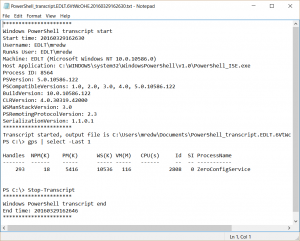Summary: Ed Wilson, Microsoft Scripting Guy, talks about using the new Windows PowerShell 5.0 ISE Transcript tool.
One of my favorite features for Windows PowerShell has always been the transcript tool. I mean, it seems like it was made for Windows PowerShell … I guess it was. What am I talking about? Well, one of my favorite ways to spend time is plugging in various Windows PowerShell commands to see what they might do. Then I try to shorten them, make them leaner, or more powerful, or modify them to better suit my needs. Back when I used to do this on other systems, I would end up copying the command, and storing it in a notebook, or in a text file. With the Windows PowerShell transcript tool, I have not only a record of my commands, and errors they generate, but also the output that comes from the command. It is a great way to learn stuff about Windows PowerShell.
The problem, is that the Start-Transcript tool only worked in the Windows PowerShell console, and I have been using the Windows PowerShell ISE more and more … so I did like any good Windows PowerShell person would do, and I wrote my own transcript tool for the Windows PowerShell ISE.
But now … there is a Windows PowerShell ISE transcript tool built into Windows PowerShell ISE … beginning with Windows PowerShell 5.0 on my Windows 10 computer.
Start the PowerShell transcript
So, the first thing I do is open the Windows PowerShell ISE, and in the command pane, I type the command Start-Transcript. The command outputs the path to the transcript. This appears here:
PS C:\> Start-Transcript
Transcript started, output file is C:\Users\mredw\Documents\PowerShell_transcript.EDL
T.6VtWcOHE.20160329162630.txt
Now I type a command. I want one that will not take up too much space, so I select the last process in the collection of objects returned by the Get-Process cmdlet (gps is an alias for get-Process). This command appears here:
PS C:\> gps | select -Last 1
Handles NPM(K) PM(K) WS(K) VM(M) CPU(s) Id SI ProcessName
——- —— —– —– —– —— — — ———–
293 18 5416 10536 116 2808 0 ZeroConfigService
Ok, now I stop the transcript. To do this, I use the Stop-Transcript cmdlet. This command once again outputs the path to the transcript file. This command and output appears here:
PS C:\> Stop-Transcript
Transcript stopped, output file is C:\Users\mredw\Documents\PowerShell_transcript.EDL
T.6VtWcOHE.20160329162630.txt
Note that the transcript file is the path to my documents folder in my profile, then the word transcript and a computer name, a bit of random number, and then the date and time. I could never remember all of tha, so I copy and paste it and try to open it in notepad. The result? An error. This appears here:
PS C:\> notepad C:\Users\mredw\Documents\PowerShell_transcript.EDL
T.6VtWcOHE.20160329162630.txt
T.6VtWcOHE.20160329162630.txt : The term ‘T.6VtWcOHE.20160329162630.txt’ is not
recognized as the name of a cmdlet, function, script file, or operable program.
Check the spelling of the name, or if a path was included, verify that the path is
correct and try again.
At line:2 char:1
+ T.6VtWcOHE.20160329162630.txt
+ ~~~~~~~~~~~~~~~~~~~~~~~~~~~~~
+ CategoryInfo : ObjectNotFound: (T.6VtWcOHE.20160329162630.txt:String
) [], CommandNotFoundException
+ FullyQualifiedErrorId : CommandNotFoundException
The problem is the path is so long, that it actually breaks into two lines. When I attempted to paste it back, I picked up a random break and the command failed. So, now I do a copy and paste again, but this time I hit backspace to remove the random break. Yeah, it works. Here is the log file:
A better way to handle this long log file path
A better way to handle this semi random long file name in a deep profile path, is to simply capture the returned output from the Start-Transcript command. Unfortunately, what returns is simply a string. This appears here:
PS C:\> $a = Start-Transcript
PS C:\> $a.GetType()
IsPublic IsSerial Name BaseType
——– ——– —- ——–
True True String System.Object
PS C:\> $a
Transcript started, output file is C:\Users\mredw\Documents\PowerShell_transcript.EDL
T.wnH7glru.20160329163437.txt
When I wrote my transcript function, I also wrote a function called Get-TranscriptFile that parsed this string into a path that I could directly pass to notepad to open the transcript. I still have that function, but another cool cmdlet in Windows PowerShell 5 makes that a bit obsolete. That is because Windows PowerShell 5 includes a cool cmdlet called ConvertFrom-String that will create an object from a string. Here is an example:
PS C:\> Convertfrom-String -InputObject $a
P1 : Transcript
P2 : started,
P3 : output
P4 : file
P5 : is
P6 : C:\Users\mredw\Documents\PowerShell_transcript.EDLT.wnH7glru.20160329163437.txt
The part I want is the P6 property. The command appears here:
Notepad (Convertfrom-String -InputObject $a).p6
Sweet! So much easier than having to write my own functions and the like. PowerShell 5 for the win!
I invite you to follow me on Twitter and Facebook. If you have any questions, send email to me at scripter@microsoft.com, or post your questions on the Official Scripting Guys Forum. Also check out my Microsoft Operations Management Suite Blog. See you tomorrow. Until then, peace.
Ed Wilson, Microsoft Scripting Guy


0 comments